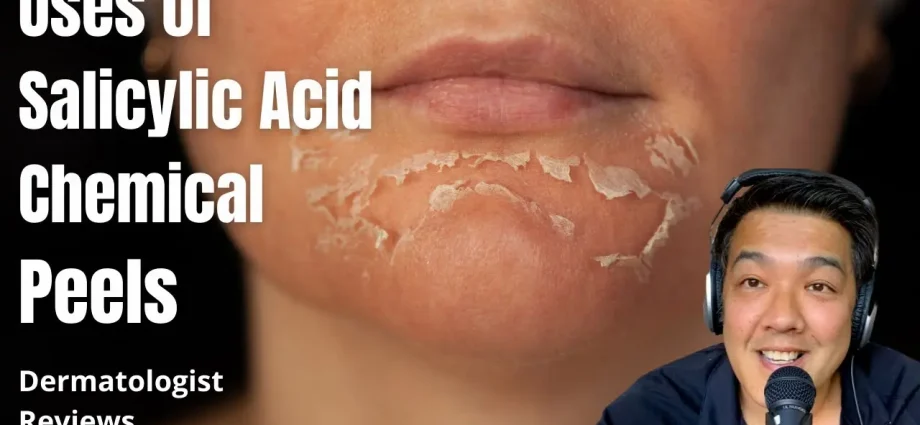Contents
Are you looking for a quick and effective remedy that can make your skin even and your complexion fresh? Consider that you have already found it – this is salicylic peeling.
When and who needs salicylic peeling
Salicylic peel effectively helps fight dull skin.
All skin types need exfoliation, so exfoliation is one of the most important steps in your beauty routine. The formation of a too dense layer of keratinized cells has unpleasant consequences, such as:
clogged pores;
acne
slow cell regeneration;
dullness of the skin;
uneven terrain.
The most affordable and popular peeling is with the help of AHA and BHA acids.
Chemical salicylic peeling is a very effective procedure, especially for the following problems:
increased oiliness of the skin;
expanded pores;
acne and post-acne;
seborrhea;
increased dryness;
pigmentation;
mimic wrinkles.
Benefits of salicylic peel
Home peeling with salicylic acid should not be done more than 1-2 times a week.
Speaking about the removal of dead cells, they usually mean the use of acid-based peels 1-2 times a week. In this article, we are talking about peeling with salicylic acid. It belongs to the BHA-acids, which are fat-soluble and due to this they can penetrate deeper into the pores through the sebum layer.
Salicylic peeling is effective for the skin:
oily;
aging;
dull;
with uneven topography.
The use of salicylic acid in cosmetology refers to professional services. After all, every mistake of an amateur is fraught with negative consequences that can lead to hospitalization.
Depending on the problem, medical indications and contraindications, the cosmetologist draws up an individual scheme for conducting salicylic peeling for the face. Also, the doctor is able to assess and prevent risks in order to determine the intensity of the procedure, the sequence of actions, which is necessary in this particular case.
Types of salicylic peeling in the salon
“Salicylic acid in its pure form is used only for relevant medical indications,” says Garnier brand expert Marina Kamanina. “The decision on the need for the procedure is made based on the results of a comprehensive examination.”
The decision on a serious salicylic peeling is made only by a doctor.
Salicylic acid in cosmetology is used for two types of peeling – superficial and median.
Superficial salicylic peeling
For acne, as well as oily and problematic skin, peeling with salicylic acid is used at a concentration of 15-20% with a pH of 2 to 3,2. This type of salicylic peeling:
reduces oily skin, regulates the activity of the sebaceous glands;
reduces pores;
fights acne.
Medium salicylic peel
If the main task of the procedure is to even out the skin relief and eliminate post-acne, then the recommended parameters for the concentration of salicylic acid are 25–30%, and the pH of the solution is 1,3–3. Such peeling helps aging skin with wrinkles, fights pigmentation.
Usually the course of salicylic peeling procedures looks like this:
for the skin of the face, neck, decollete – 5-7 procedures with an interval of 7-14 days;
for the skin of the hands – 3-5 sessions with an interval of 30 days.
Features of the peeling procedure with salicylic acid
Recall that salicylic peeling using acid in high concentrations can only be done in a clinic or salon. This procedure consists of several stages.
Make-up removal.
Apply the solution to the skin of the face, neck, décolleté with a brush.
The exposure time is determined by the doctor depending on the type of skin and problems, as well as the concentration of the drug.
Removal of the drug from the skin.
Recommendations for care. Usually they look like this: do not wash for 24 hours after a superficial salicylic peel and 48 hours after a medium one.
On the second or third day after the session, peeling appears on the skin, which you should not be afraid of. It is necessary to allow the skin itself to reject dead cells.
How to care for skin after peeling with salicylic acid
During the period of skin recovery after salicylic peeling (it takes 7-10 days), it is important to follow a few rules.
Do not scratch your face or tear off pieces of flaky skin to avoid injury.
Do not go to the bathhouse, sauna, solarium (we advise you to forget about the latter).
Do not use exfoliants.
Don’t touch your face with your hands.
Funds overview
Gel, scrub, mask “Clean Skin 3-in-1”, Garnier
Formulated with eucalyptus extract, zinc and salicylic acid, it has a triple effect: exfoliates the skin, reduces acne and blackheads, and reduces shine. For combination and oily skin.
Serum Blemish & Age Defense, SkinCeuticals
Designed to correct imperfections and age-related changes. Contains dioic, glycolic, salicylic, citric acids. Evens out the skin texture, reduces oiliness, prevents the appearance of imperfections. Apply 4-5 drops in the evening.
Face scrub “Pure Zone Absolute purity 7-in-1”, L’Oréal Paris
Salicylic acid cleanses and reduces pores, zinc gluconate fights excess oil, glycerin moisturizes, and menthol refreshes the skin.
Safety measures
After professional salicylic peeling, we advise you to be even more attentive to your skin. Within 10 days, she will be quite vulnerable, so stick to the following recommendations:
avoid direct sunlight;
apply cream with SPF 50+;
don’t use scrubs.










